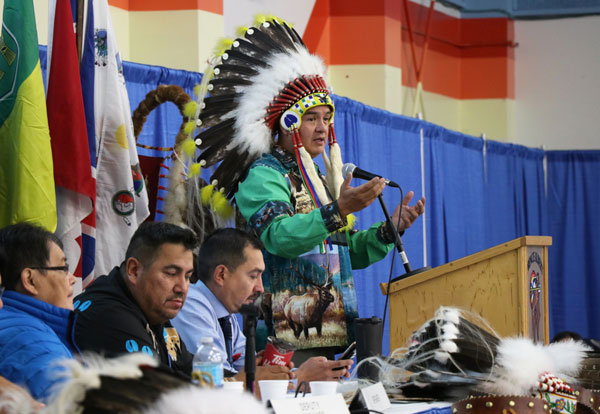The Federation of Sovereign Indigenous Nations (FSIN) is asking the federal government for $1.8 billion dollars over five years.
This comes after Bill C-92, “An Act respecting First Nations, Inuit and Métis children, youth and families,” came into effect on Jan. 1. It affirms and recognizes that Indigenous leaders have jurisdiction over child and family services.
FSIN Chief Bobby Cameron, along with four other leaders, announced the proposal at a news conference in Saskatoon on Friday.
“Our children are looking out the window, waiting for us to bring them home. We as leaders and as parents and grandparents, we’ll do our best to bring them home to our First Nations communities where they rightfully belong,” said Cameron.
But doing this, as Vice-Chief David Pratt explained, comes with investments into an oversight committee and their own children’s advocate office.
“We’re ready to proceed forward on the enabling legislation to get out from underneath the provincial child welfare act,” said Pratt, adding money from the government will help get them started.
“That work has already been ongoing. A lot of our tribal councils and our agencies are already doing that work right now.”
The five-year plan, which divides into $360 million per year, hasn’t been formally submitted to Ottawa. However, Cameron said it will likely be submitted next week.
Chief Calvin Straightnose of Keesekoose First Nation, which is near Kamsack, spoke about the harmful cultural effects of children being raised outside of their First Nations communities.
“I’m sitting here holding a cigarette. One of our sacred things is tobacco. How (many) of our children know that in care?” he questioned.
Indigenous children are overrepresented in the child welfare system. Indigenous Services Canada says First Nations, Inuit and Métis children represent 52.2 per cent of youth in foster care across the country.
“The numbers today in child welfare outnumber the number of residential school children,” emphasized Cameron.
“We must change the current system in order to build a better quality of life for our First Nations children. Things have got to change,” he said.
“Our children’s lives are at stake.”
He said in 10 or 20 years time, as they work to raise children within their cultures, Saskatchewan will start to see graduation and employment rates increase and incarceration rates decrease among the Indigenous population.
Chief John Waditaka of Wahpeton Dakota Nation spoke about the importance of housing at the conference.
“The further north that you go, the more people per household. So it’s a catch-22, if you will, and that has to be addressed before we bring our children home,” he said.
Bill C-92 was passed in June of 2019. Under the act, Indigenous groups can design and deliver their own solutions regarding child and family services. It took effect on January 1.
There are two options for an Indigenous governing body that’s developed its own legislation. It can either send a notice to the Minister of Indigenous Services and other relevant provincial or territorial governments or send a request to enter into a tripartite coordination agreement with Indigenous Services Canada and relevant provincial or territorial governments.


